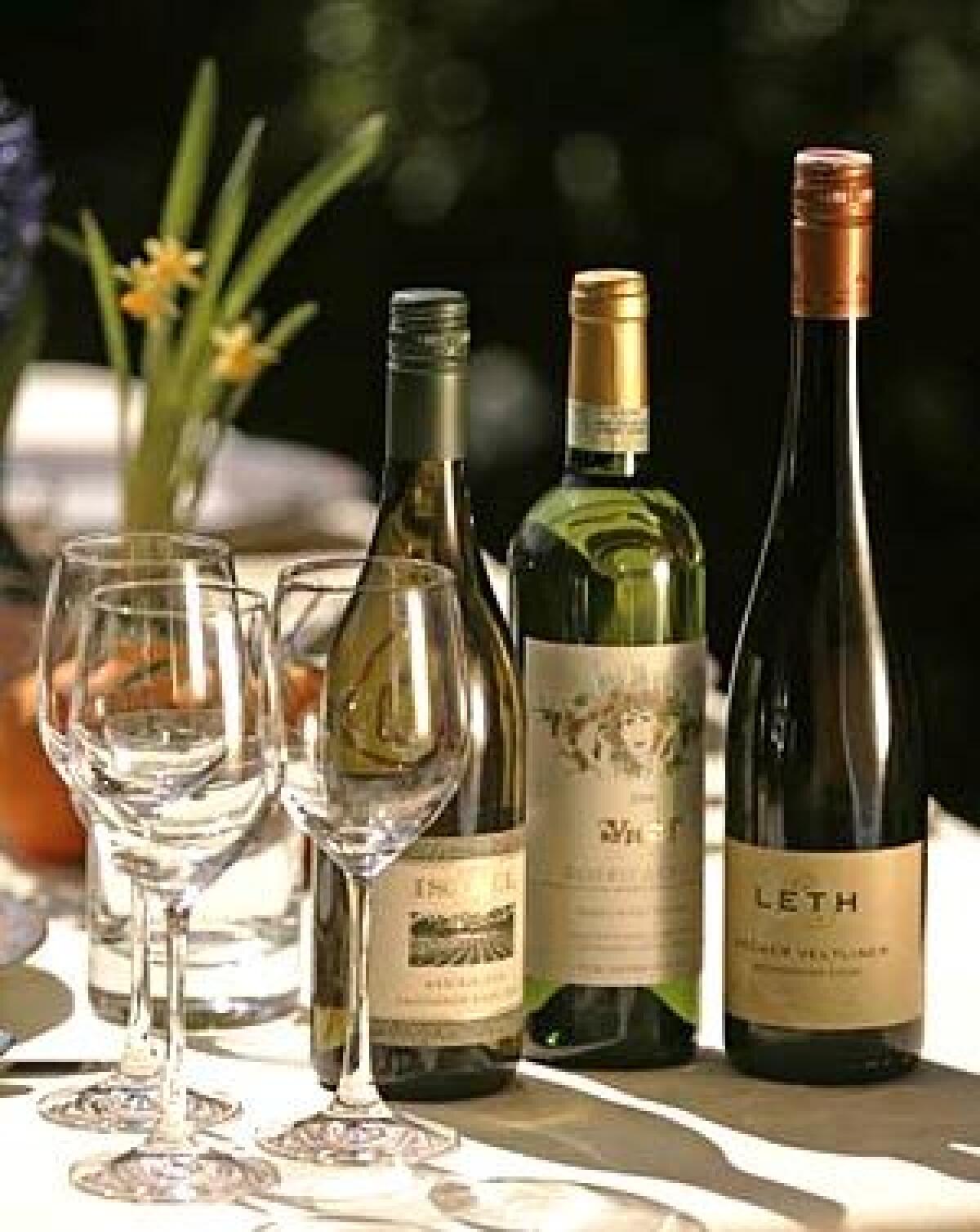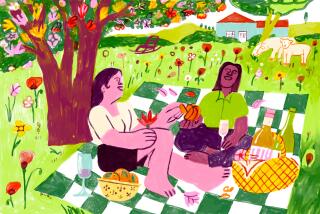White wines for your spring table

- Share via
As sure as there are flowers in April, a new crop of white wines from every corner of the world makes it to your dining room table each spring. This year, more than ever, they’ll arrive with an almost palpable pulsing energy, limpid and clean, having been aged in steel tanks rather than oak barrels. And many of them -- New Zealand Sauvignon Blancs, white wines from Greece, crisp northern Italian whites -- will lead with aromas and flavors borrowed from herb gardens and greenhouses, from produce stands and window boxes. These “green” wines infatuate the senses with aromas reminiscent of scallion, celery leaf, snap peas or young parsley sprigs. It’s hard to imagine a better accompaniment to a spring meal.
Such characteristics used to be rare in an American wine glass. Indeed, 20 years ago it was difficult to find a white wine in this country that wasn’t bathed in butter or subjected to oppressive levels of oak.
But around that time a new type of Sauvignon Blanc changed the way Americans experienced white varieties. New Zealand Sauvignons, led in large part by the Marlborough brand Cloudy Bay, blew into the market like a breeze off a fragrant meadow, with leafy scents of geranium, grass and green herbs, exotic aromas that were completely at odds with the oak-tinged regime of American white wines. There was fruit, but not the sort with which we were familiar -- here were passion fruit, gooseberry, kaffir lime. Sommeliers were captivated by this aromatic new world, and New Zealand Sauvignon Blancs became a feature of many restaurant by-the-glass programs.
Sauvignon Blanc was hardly unknown to American wine drinkers -- Sancerre and Pouilly Fumé, the great Sauvignons from France’s Loire Valley, had a foothold on many restaurant wine lists. These in their way possessed green elements, but were better known for their minerality.
Oaked Sauvignon Blanc such as white Graves from Bordeaux or Graves-inspired wines such as Robert Mondavi’s Napa Valley Fume Blanc also had a place at the table. But New Zealand’s startling success with its whites paved the way for a new class of leaner, greener, more natural tasting wines, allowing for an edgy new spectrum of flavors.
More recently, as Americans have expanded their taste for herbaceous Sauvignon into northern Italy and Australia, for example, and have grown comfortable with the pea-scented Grüner Veltliners from Austria. New indigenous aromatic varieties from Greece and Slovenia have been right behind. It seems almost like an aroma wheel of options for the dinner table, an array of accompaniments for such spring flavors as peas, green garlic, lemon grass and persillade.
In New Zealand’s image
AGREEN edge is characteristic of cool growing region, and New Zealand certainly fits the bill. Its trademark Sauvignon Blanc style was, in a sense, quite beyond its control -- at 41 degrees south latitude, with average temperatures below even the coolest California regions, its vines struggled to ripen fruit each season. In other climates, growers quickly adopted growing strategies to mimic those of cool regions, to obtain some of the fresh herbaceous quality that New Zealand grapes captured naturally.
One such measure is to set a larger number of clusters on the vine. The plant must work harder to ripen more fruit, and the growth cycle slows. Shading the fruit with a big canopy of leaves and shoots will also slow the process. In Australia, Sauvignon Blanc vines look shaggy and unkempt, with canes and shoots rocketing off the spur of the vine, and leaves shadowing the fruit beneath. That dappled sunlight, however, does much to preserve a green tinge on the fruit flavors, ensuring a racy edge.
In some parts of Australia, growers are actually pulling out Shiraz and Cabernet Sauvignon vines to plant Sauvignon Blanc and Semillon, which are blended into a warmer, slightly fleshier version of New Zealand Sauvignon Blanc. These are wildly popular wines in Australia, but there are few versions available in the U.S. Leeuwin’s “Siblings” from the Margaret River and St. Hallett’s “Poacher’s Blend” from the Barossa are two examples.
Certain of the world’s indigenous grape varieties are naturally herbaceous, highly adaptable to their home regions.
Austria’s Grüner Veltliner is a case in point. With a growing pattern that perfectly suits Austria’s not-too-hot, not-too-cool continental climate, the variety is practically synonymous in cafes and restaurants with a youthful, vibrant energy. By this point many styles of Grüner are found in Austria, but the younger wines almost always give off a green, lentil- or pea-like scent that makes one think of spring in any weather.
Greece and its islands too are home to wonderful indigenous varieties such as Malagousia and Assyrtiko, which possess exotic herbal scents. Perhaps the most springlike is a pinkish variety called Roditis, grown in the mountainous regions of the Peloponnese.
The grape is notoriously slow to reach peak ripeness, making it ideal for its warm Mediterranean climate, where it can still retain an exhilarating pine-frond scent and crisp, fennel-like flavor. One example available in the U.S. is the terse, piney Roditis from Petra called Kir-Yianni.
Perhaps the best-established of the “green” wines come from among the thousand or so white varieties found in Italy’s northern regions, where herbal-tinged varieties abound.
In the Trentino area of the Alto Adige, Sauvignon Blanc has found a new home alongside traditional Alpine varieties such as Gewürztraminer and Muller Thurgau, resulting in some of the most thrilling Sauvignons on the continent, such as the Terlaner Sauvignon from Niedrist. And from just east of the Italian border with Friuli, Slovenian wines are trickling into the market. These include the bracing lime-scented white made by the winery Primosec from an indigenous grape called Vitovska.
But no Italian wine, to my palate, is more spring-like than Arneis. This indigenous variety has rebounded from scant acreage since the 1960s, and is grown primarily in a region called Roero. These are lean, nervy wines with aromas of lemon zest and tarragon, and sprinkled with sea salt. They bear a thrilling acidity to accent fine herbal flavors. Two of the region’s oldest producers, Vietti and Bruno Giacosa, are responsible for some of the best.
Bring on the Albariño
IN California in the last 20 years, growers have generally avoided an herbaceous character in any wine, red or white -- and it’s usually too warm to really achieve consistently. Some Sauvignon Blancs from the North Coast, such as Mason and Voss, will possess an herbal top note over flavors of pear, melon and peach, especially in cooler vintages. But the Albariño (or Alvarinho) grape, a transplant from the coastal areas of Spain and Portugal, may offer hope for a more herb-inflected California white.
Most of the Iberian peninsula is quite dry and hot, but the white wine-growing regions of Vinho Verde (“green wine”) in Portugal and Rias Baixas in Spain, have a pronounced coastal influence and fine, cool whites are the norm. The principle grape variety there is called Albariño in Spain, Alvarinho in Portugal, and there’s some early evidence that this variety might produce a fine, green-scented wine in California. That was the case with a fresh, cleanly delineated 2006 Albariño from Monterey County made by Eric Laumann of Monterey Wine Co. from a brand he calls Cambiata. With its aromas of chopped parsley and lime-leaf, with its savory, sea-salt tang, it’s an American wine that fits the bill for a classic springtime white.
More to Read
Sign up for The Wild
We’ll help you find the best places to hike, bike and run, as well as the perfect silent spots for meditation and yoga.
You may occasionally receive promotional content from the Los Angeles Times.










